
|
Crowns and conventional bridges or dentures may not be your only options when replacing missing teeth. For some people, dental implants offer a smile that looks and feels very natural. Surgically placed below the gums over a series of appointments, implants fuse to the jaw bone and serve as a base for individual replacement teeth, bridges, or a denture.
What are dental implants and what can they do for me? A dental implant is an artificial root placed into your jaw to hold a replacement tooth or bridge in place. After placement, the implant fuses to the bone of your jaw and acts as an artificial tooth root. Replacement teeth, singularly or grouped on a bridge or denture, are then mounted to the implant(s). What are the advantages of dental implants?
Am I a candidate for dental implants? The ideal candidate for a dental implant is in good general and oral health. Adequate bone in the jaw is needed to support the implant, and the best candidates have healthy gum tissue free of periodontal disease. Some chronic diseases such as diabetes, osteoporosis, or chronic sinus problems may interfere with proper healing and could prevent the bone from attaching to the implant. Long-term medication use and certain behaviors like smoking also may affect the stability of the implant over time.
What can I expect after treatment? Dental implants are like your own teeth and will require the same conscientious at-home oral care and regular dental visits. In order to keep your implant clean and plaque free, brushing and flossing still apply.
What are implants made of? The implant itself is made of metal, usually titanium, which has proven to be very compatible with bone and other tissues. Like conventional crowns and bridges, the replacement teeth mounted on the implants are made of porcelain or porcelain and metal. What else should I know about implants? As with any medical or dental procedure, implant placement is not always successful. Complications related to healing factors could influence long-term retention of the implant. Placing the implant and allowing the bone to fuse with the implant will take some time. The entire procedure can take place over a few months and usually involves more than one surgical appointment. Placement and adjustment of the artificial teeth also may require more than one appointment. |
| This patient lost her lower left first and second bicuspid teeth, they were replaced with two implants. | ||
 fig. 1 |
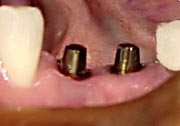 fig. 2 |
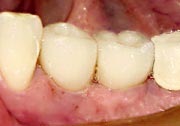 fig. 3 |
| fig. 1: The xray shows the two implants integrated with the jaw bone. fig. 2: The two implants with the posts that will support the crowns. fig. 3: The two crowns cemented on the posts. |
||
| This patient lost his upper right first molar which was replaced with an implant. | ||
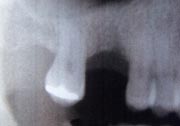 fig. 1 |
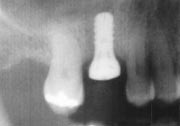 fig. 2 |
 fig. 3 |
| fig. 1: The xray shows the healed extraction site before the implant was placed. fig. 2: The xray shows the implant in place and integrated with the bone. fig. 3: The arrow points to the crown placed on the implant. |
||
| This patient lost his upper left first molar which was replaced with an implant. | ||
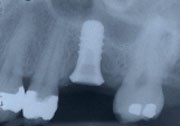 fig. 1 |
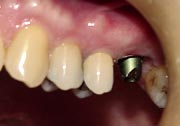 fig. 2 |
 fig. 3 |
| fig. 1: The xray shows the implant integrated with the jaw bone. fig. 2: The implant with the post that will support the crown. fig. 3: The crown cemented on the post. |
||
| This patient lost many of her upper teeth which were replaced with implants. | ||
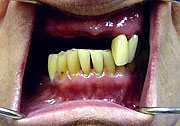 fig. 1 |
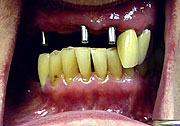 fig. 2 |
 fig. 3 |
| fig. 1: The upper jaw with missing teeth. fig. 2: The implants with the posts that will support the permanent bridge. fig. 3: The implant supported permanent bridge in place. |
||
| This patient lost eight lower teeth from periodontal disease which were replaced with implants. | ||
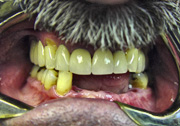 fig. 1 |
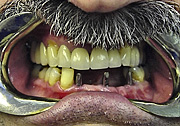 fig. 2 |
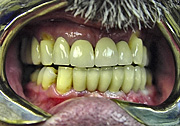 fig. 3 |
| fig. 1: The lower jaw with missing teeth. fig. 2: The implants with the posts that will support the permanent bridge. fig. 3: The implant supported permanent bridge in place. |
||
Bonding | Veneers | Crowns | Bleaching | Recontouring | Periodontal Disease | Fluoride | Sealants | Prevention | Tooth Topics | History | Children | Endodontics | Materials | TMD | FAQ | Prosthodontics | Implants